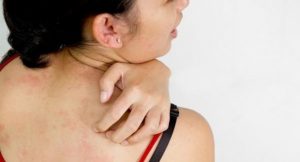Prickly heat is also known as heat rash and miliaria. This is not a condition which is affecting just babies. Also it can affect adults, especially during hot and humid weather. This occurs when blocked pores – sweat ducts, trap perspiration under the skin. Symptoms of prickly heat can range from superficial blisters to deep and red lumps. There are some forms of the heat rash which feel prickly or intensely itchy. In the most cases heat rashes heals on its own. If you have severe form of prickly heat, then this needs medical care but the best way to get a relief from the symptoms is to cool your skin and prevent sweating. [5]
Symptoms of prickly heat
In infants, the heat bumps are mainly found on the chest, shoulders and neck. Also it can show up in the groin, elbow creases and armpits. Adults develop heat rashes in skin folds and where their clothing causes friction. The most common symptoms of heat rashes are red bumps on the skin and an itchy or prickly feeling to the skin. These symptoms are caused by the inflammation of the superficial layers of the skin – epidermis and the prickly sensation is similar to the feeling of mild sunburn. The symptoms of the heat rash are the same in adults and infants. We know that infants cannot complain about the rash sensation they have, so they can be fussy.
Causes: Prickly heat is happening when some of the sweat ducts clog. Instead of evaporating, the perspiration gets trapped beneath your skin which is causing inflammation and rash. It is not always clear why the sweat ducts become blocked but there are some factors which can play a role in it such as
- Prolonged bed rest: Prickly heat can happen in people who are confined to their beds for long periods, especially if they suffer from a fever. [1,2]
- Overheating: Overheating in general, such as sleeping under an electric blanket or dressing too warmly, could lead to prickly heat [3].
- Physical activity: Hard work, intense exercise or any activity which is causing you to sweat heavily can lead to prickly heat.
- Tropical climates: Hot and humid weather can lead to prickly heat [4].
- Immature sweat ducts: You should know that the sweat ducts of newborns are not fully developed. They can rupture more easily which will trap their perspiration beneath their skin. Prickly heat can happen in the first week of life, especially if the infant has a fever, is dressed to warmly or he is being warmed in an incubator.
Types of prickly heat
The types of prickly heat are classified according to how deep the blocked sweat ducts are. Signs and symptoms of each type vary.
- Miliaria crystallina: This is the mildest form of prickly heat. It is affecting the sweat ducts in the top layer of the skin. This type of prickly heat is characterized by clear and fluid – filled blisters and bumps, papules, which are breaking easily.
- Miliaria rubra: This is a type of prickly heat which is happening deeper in the skin. Signs and symptoms of this type are including red bumps and itching or prickling in the affected area.
- Miliaria pustulosa: In this type of prickly heat, there are some rare cases when the fluid – containing sacs, vesicles, of miliaria rubra become inflamed and pus – filled, pustural.
- Miliaria profunda: This is a less common form of prickly heat. It is affecting the dermis which is the deeper layer of the skin. The retained sweat leaks out of the sweat gland into the skin which is causing firm and flesh – colored lesions which resemble goose bumps.
Risk factors: There are some factors which can increase your risk of prickly heat such as
- Physical activity: Anything which makes you sweat heavily, especially if you do not wear clothes that allow the sweat to evaporate, can trigger the heat rash [4].
- Age: It is known fact that newborns are having the biggest risk of getting heat rashes. [5]
- Tropical climates: People who are living in tropics are having bigger risk of developing prickly heat compared to people who live in temperate climates [6].
Complications: In the most cases prickly heat heals without problem but also there are some cases when it can lead to infection with bacteria that is causing itchy and inflamed pustules.
References:
[1] Sarabon N, Mekjavic IB, Eiken O, Babic J. The effect of bed rest and hypoxic environment on postural balance and trunk automatic (re)actions in young healthy males. Frontiers in Physiology. 2018.
[2] Cheshire WP. Thermoregulatory disorders and illness related to heat and cold stress. Autonomic Neuroscience. 2016;196:91-104.
[3] Dusang K. Don’t sweat the heat rash. Baylor College of Medicine. 2019. Retrieved from www.bcm.edu/news/dont-sweat-the-heat-rash
[4] Nichols AW. Heat-related illness in sports and exercise. Current Reviews in Musculoskeletal Medicine. 2014;7(4):355–65.
[5] University of Florida Health. Babies and heat rashes. Retrieved from ufhealth.org/babies-and-heat-rashes
[6] Critchley M. Effects of climatic extremes. British Journal of Industrial Medicine. 1947;4(3):164-90.





